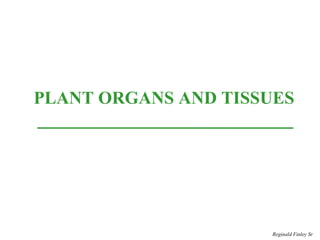
Plant Organs and Tissues Presentation
- 1. PLANT ORGANS AND TISSUES Reginald Finley Sr
- 2. • There are now more than 400,000 known species of plant. The flowering plants (angiosperms) are by far the most diverse and widespread group of land plants. • Plants have structural and physiological adaptations that help them survive in a wide variety of environments. Introduction
- 3. • Scientists tend to divide all plants into two large groups: The Bryophytes and the Tracheophytes. Two Main Plants Bryophytes include: mosses, liverworts, and hornworts Tracheophytes include: ferns, pines, and flowering plants • Bryophytes are considered nonvascular which means that they don’t have specialized tissues to transport water and nutrients. Tracheophytes are called vascular because they do!
- 4. • Roots: – Roots anchor and support the plant. It also provides water and dissolved nutrients from the soil. They also provide food and store water. – Most absorption of water and minerals is done at the root tips where tiny root hairs increase surface area. The root tips also grows new cells quickly for growth and to replenish damaged cells as it grows. – There are two types of roots. Taproots and Fibrous roots. Carrots (a dicot) are an example of a tap root. Grasses and many weeds have fibrous roots From The Ground Up
- 5. • Transport System Tracheophytes can grow to large sizes because of their vascular tissue (their transport system). Tracheophytes have two main types of vascular tissue: Xylem and Phloem! Xylem moves water and nutrients from the ground upward in the plant. Phloem carries food made in the plant’s leaves down to other parts of the plant.
- 6. • Stems Stems transport materials between a plant’s roots and its leaves and flowers. They also provide support. In some plants, stems store food and water. Xylem and Phloem are within the stem.
- 7. Pause, Think, Digest • What is the most widespread type of plant? Angiosperms • What is the difference between a Bryophyte and a Tracheophyte? Non-vascular vs Vascular • What is Xylem and Phloem? Vascular Tissues, Xylem moves water upward into the plant while phloem carries food to other plant parts
- 8. • The Leaf – Leaves are the main organs that carry out photosynthesis in a plant. – Leaf size, shape, and structure are vital to plant survival. – What organelles are responsible for photosynthesis? – Chloroplasts – Leaves have tiny openings called Stomata in which CO2 and O2 are exchanged. – Guard cells around the stomata control the size of the opening.
- 9. • Monocots and Dicots Plant scientists can look at a leaf and tell you what kind of plant it is. Most monocots have parallel major veins that run the length of the blade (like grass), while dicot leaves have a multi- branched network of major veins. Now you can tell the difference too! ???
- 10. • Gymnosperms and Angiosperms An Angiosperm is a flowering plant that reproduces by producing seeds from Fruits. Like this beautiful Magnolia: Gymnosperms are plants that produce seeds but their seeds are within Cones or cone-like structures like a Pine cone from A Pine tree:
- 11. • Flower Structure and Reproduction
- 12. • Flower Structure and Reproduction II Plants can reproduce sexually or asexually. If reproducing sexually, pollen must come from the anthers in the stamen (the male portion carrying the sperm) and captured by the stigma (The female portion). Pollen is transferred by wind or pollinators such as birds, insects, or even humans.
- 13. • Seeds, Cones, and Spores Seeds are produced from fruits. Inside the seed is the plant embryo; from which, a new plant arises. Food is also stored in the endosperm. This provides the embryo with the energy it needs to grow. Pines trees, a type of conifer, uses cones to reproduce, but instead of being enclosed in a fruit, the fertilized eggs are open to the elements and either fall to the ground or drift away in the wind. Spores come from many non-vascular plants such as mosses. One spore can produce an entirely new organism.
- 14. Today’s Meet Discussion • What are the organelles in leaves which assist with gas exchange and water movement into and out of the leaf? Stomata and Guard Cells • What is the difference between a monocot and a dicot? Monocot parallel veins, Dicots branch • What parts of the Plant deal with reproduction? Stamen (anther-contains the pollen), Pistil (stigma-leads to ovary)
- 15. Video on Plant Reproduction (if time allots) https://www.youtube.com/watch?v=HLYPm2idSTE
